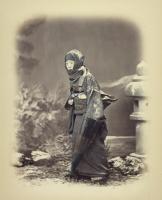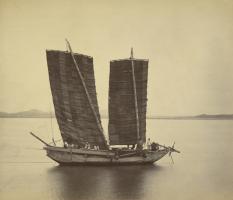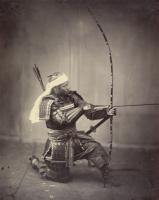
Felice Beato, Panorama of Yeddo from Atagoyama, ca. 1863-64, albumen silver print, Tokyo Metropolitan Museum of Photography
Felice Beato
A Photographer on the Eastern Road
Mar. 6—May. 6, 2012
- Mar. 6—May. 6, 2012
- Closed Monday(if Monday is a national holiday or a substitute holiday, it is the next day)
- Admission:Adults ¥800/College Students ¥700/High School and Junior High School Students, Over 65 ¥600
The J. Paul Getty Museum, Los Angeles and the Tokyo Metropolitan Museum of Photography display first survey of Felice Beato's long and varied photography career
 Felice Beato, Woman in Winter Dress, about 1868.
Felice Beato, Woman in Winter Dress, about 1868.
Hand-colored albumen silver print
Partial gift from the Wilson Centre for Photography. The J. Paul Getty Museum, Los Angeles.
After premiering at the J. Paul Getty Museum in Los Angeles last winter, Felice Beato: A Photographer on the Eastern Road, will be on view at the Tokyo Metropolitan Museum of Photography in Tokyo, Japan.
Felice Beato: A Photographer on the Eastern Road will present the first survey of Felice Beato's (British, born Italy, 1832–1909) long and varied photography career which covered a wide geographical area - from the Middle East to Southeast Asia. Felice Beato, The First Korean Junk Bringing Despatches, 1871, albumen silver print
Felice Beato, The First Korean Junk Bringing Despatches, 1871, albumen silver print
The J. Paul Getty Museum, Los Angeles, Partial gift from the Wilson Centre for Photography
The exhibition looks closely at the photographs Beato made during his peripatetic career that spanned four decades. Following in the wake of Britain's colonial empire, Beato was among the primary photographers to provide images of newly opened countries such as India, China, Japan, Korea, and Burma. "Felice Beato was one of the first global photographers," explains Anne Lacoste, curator of the exhibition from the J. Paul Getty Museum, Los Angeles. "No one before him was present with a camera in so many different countries to chronicle conflicts or to record their foreign cultures... ."
His photographs of battlefields, the first to show evidences of the dead, provided a new direction for war photography. Felice Beato: A Photographer on the Eastern Road examines also the ways Beato tailored his images of foreign cultures to the Western audience. As Western colonial empires expanded in the second half of the nineteenth century, the market for photographs of distant lands grew dramatically. Tourists and armchair travelers who sought enrichment through reading image-laden travel diaries were Beato's primary clients. Beato produced an exceptionally diverse oeuvre: topographical and architectural views, including panoramas, as well as portraits and costume studies of the countries he visited or in which he resided.

Felice Beato, Samurai with Long Bow, 1863, albumen silver print
The J. Paul Getty Museum, Los Angeles, Partial gift from the Wilson Centre for Photography
In 1863 Beato opened a photography studio in Yokohama, Japan, where he spent more than 20 years producing the first significant series of photographs made by a Western photographer in that country. During his time in Japan, one of Beato's most important innovations was the introduction of the art of coloring photographs. He used watercolor instead of oil pigments, which provided greater translucency and resulted in a subtle but vibrant colored photograph. Beato also offered the first photographic albums in the country that included scenic views and costume studies depicting Japanese domestic life. They presented an overview of Japanese culture and were sold as souvenirs to tourists.
On view in Tokyo Metropolitan Museum of Photography, the exhibition is supplemented with the exquisite group of photographs from this museum's collection, giving a remarkable and rare visual record of Japan from the most turbulent periods in Japanese history, when the Tokugawa shogunate gave way to the Meiji reign. "Viewing this exhibition is like looking into a time capsule sealed for over 100 years" – adds Keishi Mitsui, curator from the Tokyo Metropolitan Museum of Photography.
Lectures:
■March 6, 4pm-6pm: complimentary lectures by Anne Lyden and Sarah Freeman (J. Paul Getty Museum, Los Angeles)
■March 16; April 6, 20; April 29-30&May 1-6 (everyday), 4pm-5pm: floor lectures by Keishi Mitsui (Tokyo Metropolitan Museum of Photography)
■April 15, 630pm-8pm: "Time capsule of the Bakumatsu period" – lecture by prof. Norihide Takahashi (Nihon University)





![チラシ1[pdf]](http://topmuseum.jp/upload/4/1539/thums/beato1.png)
![出品作品リスト1[pdf]](http://topmuseum.jp/upload/4/1539/thums/beato.png)